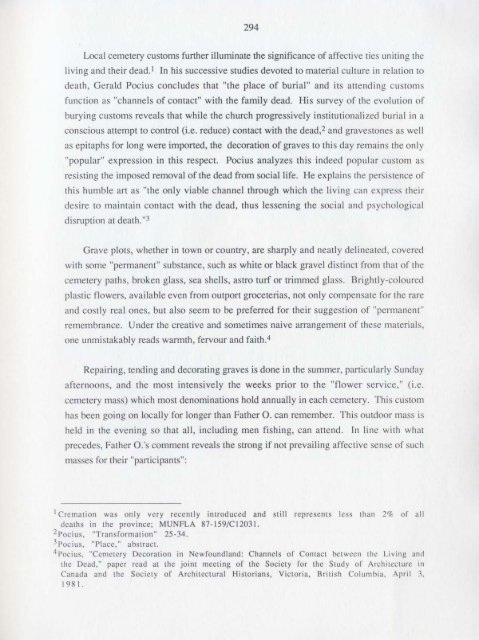Untitled - Memorial University's Digital Archives - Memorial ...
Untitled - Memorial University's Digital Archives - Memorial ...
Untitled - Memorial University's Digital Archives - Memorial ...
Create successful ePaper yourself
Turn your PDF publications into a flip-book with our unique Google optimized e-Paper software.
294<br />
Local cemetery customs further illuminate the significance of affcctive lies uniting the<br />
living and their dead. 1 In his successive studies devoted to material culture in relation 10<br />
death, Gerald Pocius concludes that "the place of burial" and its attending customs<br />
function as "channels of contact" with the family dead. His survey of the evolution of<br />
burying customs reveals that while the church progressively institutionalized burial in a<br />
conscious allempt to control (i.e. reduce) contact with the dead,2 and gravestones as well<br />
as epitaphs for long were imported, the decoration of graves to this day remains the only<br />
"popular" expression in this respect. Pocius analyzes this indeed popular custom as<br />
resisting the imposed removal of the dead from social life. He explains the persislence of<br />
this humble art as "the only viable channel through which the living can express their<br />
desire to maintain contact with the dead, thus lessening the social and psychological<br />
disruption at death."3<br />
Gmve plots, whether in IOwn or country, are sharply and neatly delineated, covered<br />
with some "permanent" substance, such as white or black gravel distinct from that of lhe<br />
cemetery paths, broken glass, sea shells, astro turf or trimmed glass. Brightly-coloured<br />
plastic flowers, available even from outport groceterias, not only compensate for the rare<br />
and costly real ones, but also seem to be preferred for their suggestion of "permanent"<br />
remembrance. Under the creative and sometimes naive arrangemcnl of lhese malcrials,<br />
one unmistakably reads wannth, fervour and faith. 4<br />
Repairing, tending and decorating graves is done in the summer, particularly Sunday<br />
afternoons, and the most intensively the weeks prior 10 the "flower service," (i.e.<br />
cemetery mass) which most denominations hold annually in each cemetery. This custom<br />
has been going on locally for longer than Father O. can remember. This olltdoor mass is<br />
held in the evening so that all, including men fishing, can attend. In line with whal<br />
preccdes, Father 0.'5 comment reveals the strong if not prevailing affective sense of such<br />
masses for their "participants":<br />
I Cremation was only very rccently introduced and still represents less lhan 2% of all<br />
dealhs in lhe provincc; MUNFLA 87-159/Cl2031.<br />
2Poeius, "Transformation" 25-34.<br />
3pocius, "Place," abstract.<br />
4 Pocius, "Cemelery Decoration in Ncwfoundland: Channels of Conlaet betwecn the Living and<br />
lhe Dead," paper read at lhe joint mecting of the Society for the Study of Architccture in<br />
Canada and lhe Society of Architectural Historians, Vicloria, British Columbia, April 3,<br />
19R1

















